Comparing the Pressure on the Carpal Tunnel When Using an Ergonomic Pointer Driver and an Optical Alternative
Abstract
1. Introduction
2. Materials and Methods
2.1. Hardware Details of the IR Device and BDS
2.2. Characterization of the IR Device and BDS
2.3. Configuring the IR Device and the Test Interface
2.4. Data Processing and Statistical Analysis
3. Results
3.1. Initial Tests
3.2. Solving the Predefined Computing Tasks
4. Discussion
5. Conclusions
6. Patents
Author Contributions
Funding
Institutional Review Board Statement
Informed Consent Statement
Data Availability Statement
Acknowledgments
Conflicts of Interest
References
- Hagberg, M.; Morgenstern, H.; Kelsh, M. Impact of occupations and job tasks on the prevalence of carpal tunnel syndrome. Scan. J. Work Environ. Health 1992, 18, 337–345. [Google Scholar] [PubMed]
- McDiarmid, M.; Oliver, M.; Ruser, J.; Gucer, P. Male and female rate differences in carpal tunnel syndrome injuries: Personal attributes or job tasks? Environ. Res. 2000, 83, 23–32. [Google Scholar] [CrossRef] [PubMed]
- Bongers, F.J.; Schellevis, F.G.; van den Bosch, W.J.; van der Zee, J. Carpal tunnel syndrome in general practice (1987 and 2001): Incidence and the role of occupational and non-occupational factors. Br. J. Gen. Pract. 2007, 57, 36–39. [Google Scholar] [PubMed]
- Keir, P.J.; Bach, J.M.; Rempel, D. Effects of computer mouse design and task on carpal tunnel pressure. Ergonomics 1999, 42, 1350–1360. [Google Scholar] [CrossRef] [PubMed]
- Fagarasanu, M.; Kumar, S. Carpal tunnel syndrome due to keyboarding and mouse tasks: A review. Int. J. Ind. Ergon. 2003, 31, 119–136. [Google Scholar] [CrossRef]
- Thomsen, J.F.; Gerr, F.; Atroshi, I. Carpal tunnel syndrome and the use of computer mouse and keyboard: A systematic review. BMC Musculoskelet. Disord. 2008, 9, 134. [Google Scholar] [CrossRef]
- Dakowicz, A.; Kuryliszyn, A.; Kosztyła, B.; Moskal, D.; Latosiewicz, R. Comparison of the long–term effectiveness of physiotherapy programs with low–level laser therapy and pulsed magnetic field in patients with carpal tunnel syndrome. Adv. Med. Sci. 2011, 56, 270–274. [Google Scholar] [CrossRef]
- Bullock, I.M.; Feix, T.; Dollar, A.M. Workspace Shape and Characteristics for Human Two-and Three-Fingered Precision Manipulation. IEEE Trans. Biomed. Eng. 2015, 62, 2196–2207. [Google Scholar] [CrossRef]
- Schmid, A.B.; Kubler, P.A.; Johnston, V.; Coppieters, M.W. A vertical mouse and ergonomic mouse pads alter wrist position but do not reduce carpal tunnel pressure in patients with carpal tunnel syndrome. Appl. Ergon. 2015, 47, 151–156. [Google Scholar] [CrossRef]
- Trillos-Chacón, M.C.; Castillo-M, J.A.; Tolosa-Guzman, I.; Medina, A.F.; Ballesteros, S.M. Strategies for the prevention of carpal tunnel syndrome in the workplace: A systematic review. Appl. Ergon. 2021, 93, 103353. [Google Scholar] [CrossRef]
- Kalakatawi, M.H.; Aziz, N. Impact of Covid-19 pandemic on the clinical profile of patients in Neurophysiology clinic. World J. Adv. Res. Rev. 2021, 9, 319–325. [Google Scholar] [CrossRef]
- Padua, L.; Coraci, D.; Erra, C.; Pazzaglia, C.; Paolasso, I.; Loreti, C.; Caliandro, P.; Hobson-Webb, L.H. Carpal tunnel syndrome: Clinical features, diagnosis, and management. Lancet Neurol. 2016, 15, 1273–1284. [Google Scholar] [CrossRef] [PubMed]
- Wipperman, J.; Goerl, K. Carpal tunnel syndrome: Diagnosis and management. Am. Fam. Physician 2016, 94, 993–999. [Google Scholar] [PubMed]
- Wei, Y.; Zhang, W.; Gu, F. Towards diagnosis of carpal tunnel syndrome using machine learning. In Proceedings of the 2020 3rd Artificial Intelligence and Cloud Computing Conference, Kyoto Japan, 18–20 December 2020; pp. 76–82. [Google Scholar] [CrossRef]
- Watanabe, T.; Xia, C.; Fujita, K.; Sugiura, Y. Screening for Carpal Tunnel Syndrome Using Daily Behavior on Mobile Devices. Computer 2023, 56, 62–70. [Google Scholar] [CrossRef]
- Ballestero, R.; Plaza, G.; Urraca, A.; Romo, F.; de los Ángeles, A.; Pecos, D.; Gallego, T.; Romero, N. Effectiveness of nerve gliding exercises on carpal tunnel syndrome: A systematic review. J. Manip. Physiol. Ther. 2017, 40, 50–59. [Google Scholar] [CrossRef]
- Hamzeh, H.; Madi, M.; Alghwiri, A.A.; Hawamdeh, Z. The long-term effect of neurodynamics vs exercise therapy on pain and function in people with carpal tunnel syndrome: A randomized parallel-group clinical trial. J. Hand Ther. 2021, 34, 521–530. [Google Scholar] [CrossRef]
- Akdağ, M.A.; Menekşeoğlu, A.K.; Seğmen, H.; Gözek, B.; Korkmaz, M.D.; Güçlü, B. Measuring tactile sensitivity and mixed-reality-assisted exercise for carpal tunnel syndrome by ultrasound mid-air haptics. Front. Neurosci. 2024, 18, 1319965. [Google Scholar] [CrossRef]
- Lewis, K.J.; Coppieters, M.W.; Ross, L.; Hughes, I.; Vicenzino, B.; Schmid, A.B. Group education, night splinting, and home exercises reduce conversion to surgery for carpal tunnel syndrome: A multicentre randomised trial. J. Physiother. 2020, 66, 97–104. [Google Scholar] [CrossRef]
- Pachoulakis, I.; Tsilidi, D. Technology-assisted Carpal Tunnel Syndrome Rehabilitation using serious games: The Roller Ball example. Adv. Image Video Process. 2016, 4, 24–30. [Google Scholar] [CrossRef]
- Pachoulakis, I.; Tsilidi, D.; Analyti, A. Computer-Aided Rehabilitation for the Carpal Tunnel Syndrome using Exergames. Adv. Image Video Process. 2018, 6, 44–56. [Google Scholar] [CrossRef][Green Version]
- Schofield, J.S.; Evans, K.R.; Hebert, J.S.; Marasco, P.D.; Carey, J.P. The effect of biomechanical variables on force sensitive resistor error: Implications for calibration and improved accuracy. J. Biomech. 2016, 49, 786–792. [Google Scholar] [CrossRef] [PubMed]
- Estrada, J.C.; Sámano, A.H.; Mazón, E.E.; Paz, J.A.; González, A.; Leyva, J.A.; Cano, M.E. A viable wireless PC assisted alternative to studies of vectorcardiography. Dyna 2015, 82, 118–126. [Google Scholar] [CrossRef]
- Jiménez, M.; Cano, M.E.; Flores, O.; Estrada, J.C. A portable embedded system for point-to-point secure signals transmission. Microprocess. Microsyst. 2018, 1, 126–134. [Google Scholar] [CrossRef]
- Kubo, K.; Cheng, Y.S.; Zhou, B.; An, K.N.; Moran, S.L.; Amadio, P.C.; Zhang, X.; Zhao, C. The quantitative evaluation of the relationship between the forces applied to the palm and carpal tunnel pressure. J. Biomech. 2018, 66, 170–174. [Google Scholar] [CrossRef] [PubMed]
- Ahn, S.Y.; Hong, Y.H.; Koh, Y.H.; Chung, Y.S.; Lee, S.H.; Yang, H.J. Pressure measurement in carpal tunnel syndrome: Correlation with electrodiagnostic and ultrasonographic findings. J. Korean Neurosurg. Soc. 2009, 46, 199–204. [Google Scholar] [CrossRef]
- Werner, C.O.; Elmqvist, D.; Ohlin, P. Pressure and nerve lesion in the carpal tunnel. Acta Orthop. Scand. 1983, 54, 312–316. [Google Scholar] [CrossRef]
- Shields, J.E.; Hernandez-Sarabia, J.A.; Lanza, M.B.; Barrera-Curiel, A.; Luera, M.J.; DeFreitas, J.A. Comparison of Popular Filters for Surface Electromyography. SSRN 2024, 14p. [Google Scholar] [CrossRef]
- Putra, D.S.; Weru, Y.U.W. Pattern recognition of electromyography (EMG) signal for wrist movement using learning vector quantization (LVQ). In IOP Conference Series: Materials Science and Engineering; IOP Publishing: Bristol, UK, 2019; Volume 506, p. 012020. [Google Scholar] [CrossRef]
- Besomi, M.; Hodges, P.W.; Clancy, E.A.; Van Dieën, J.; Hug, F.; Lowery, M.; Merletti, R.; Søgaard, K.; Wrigley, T.; Besier, T.; et al. Consensus for experimental design in electromyography (CEDE) project: Amplitude normalization matrix. J. Electromyogr. Kinesiol. 2020, 53, 102438. [Google Scholar] [CrossRef]
- Leijnse, J.N.; Campbell-Kyureghyan, N.H.; Spektor, D.; Quesada, P.M. Assessment of individual finger muscle activity in the extensor digitorum communis by surface EMG. J. Neurophysiol. 2008, 100, 3225–3235. [Google Scholar] [CrossRef]
- Trinidad-Fernández, M.; González-Molina, F.; Moya-Esteban, A.; Roldán-Jiménez, C.; González-Sánchez, M.; Cuesta-Vargas, A.I. Muscle activity and architecture as a predictor of hand-grip strength. Physiol. Meas. 2020, 41, 075008. [Google Scholar] [CrossRef]
- Wolf, L.D.; Matheson, L.N.; Ford, D.D.; Kwak, A.L. Relationships among grip strength, work capacity, and recovery. J. Occup. Rehabil. 1996, 6, 57–70. [Google Scholar] [CrossRef] [PubMed]
- Vinjamuri, R.; Mao, Z.H.; Sclabassi, R.; Sun, M. Limitations of surface EMG signals of extrinsic muscles in predicting postures of human hand. In Proceedings of the 2006 International Conference of the IEEE Engineering in Medicine and Biology Society, New York, NY, USA, 30 August–3 September 2006; pp. 5491–5494. [Google Scholar] [CrossRef]
- Jennett, C.; Cox, A.L.; Cairns, P.; Dhoparee, S.; Epps, A.; Tijs, T.; Walton, A. Measuring and defining the experience of immersion in games. Int. J. Hum. Comput. Stud. 2008, 66, 641–661. [Google Scholar] [CrossRef]

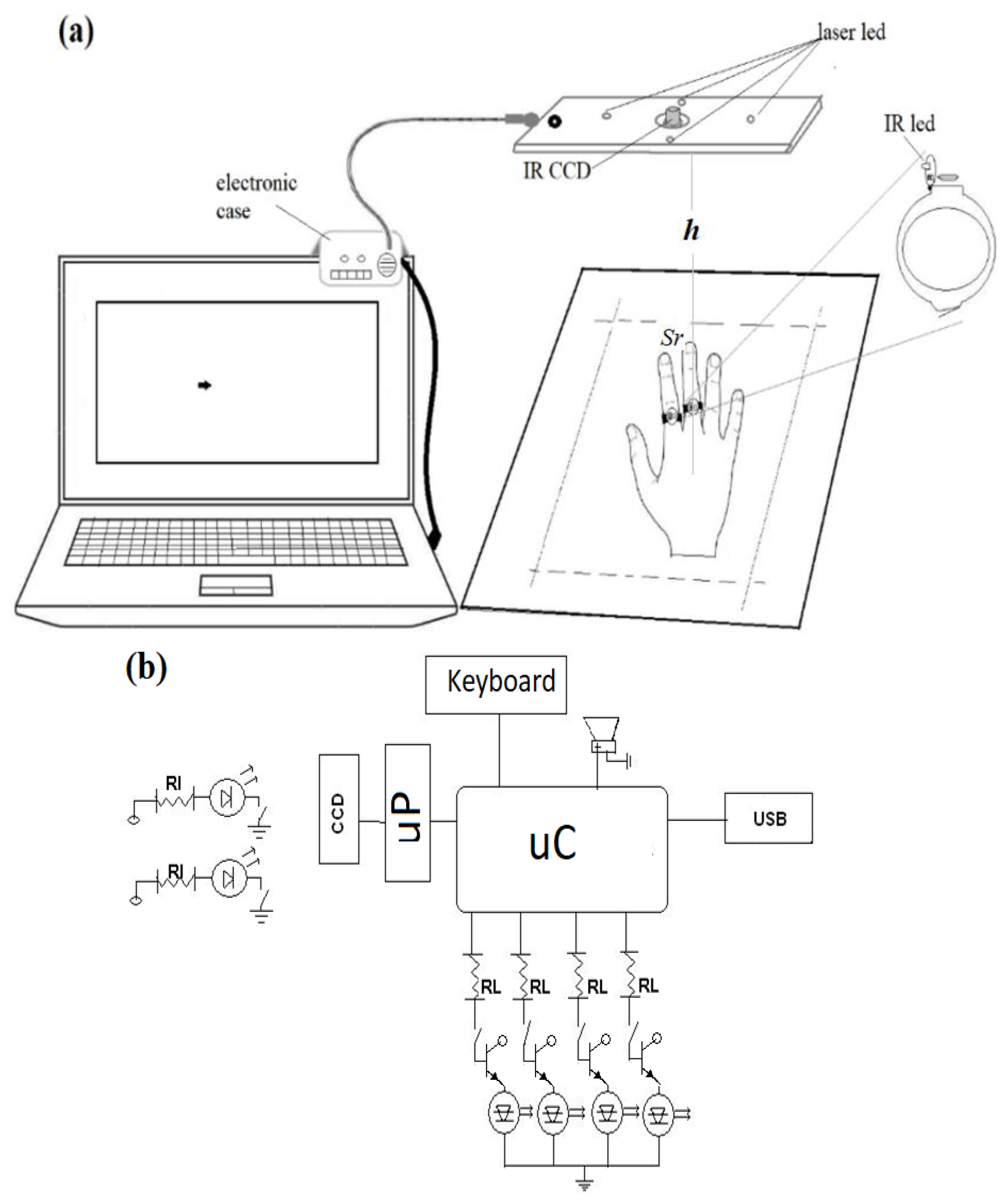
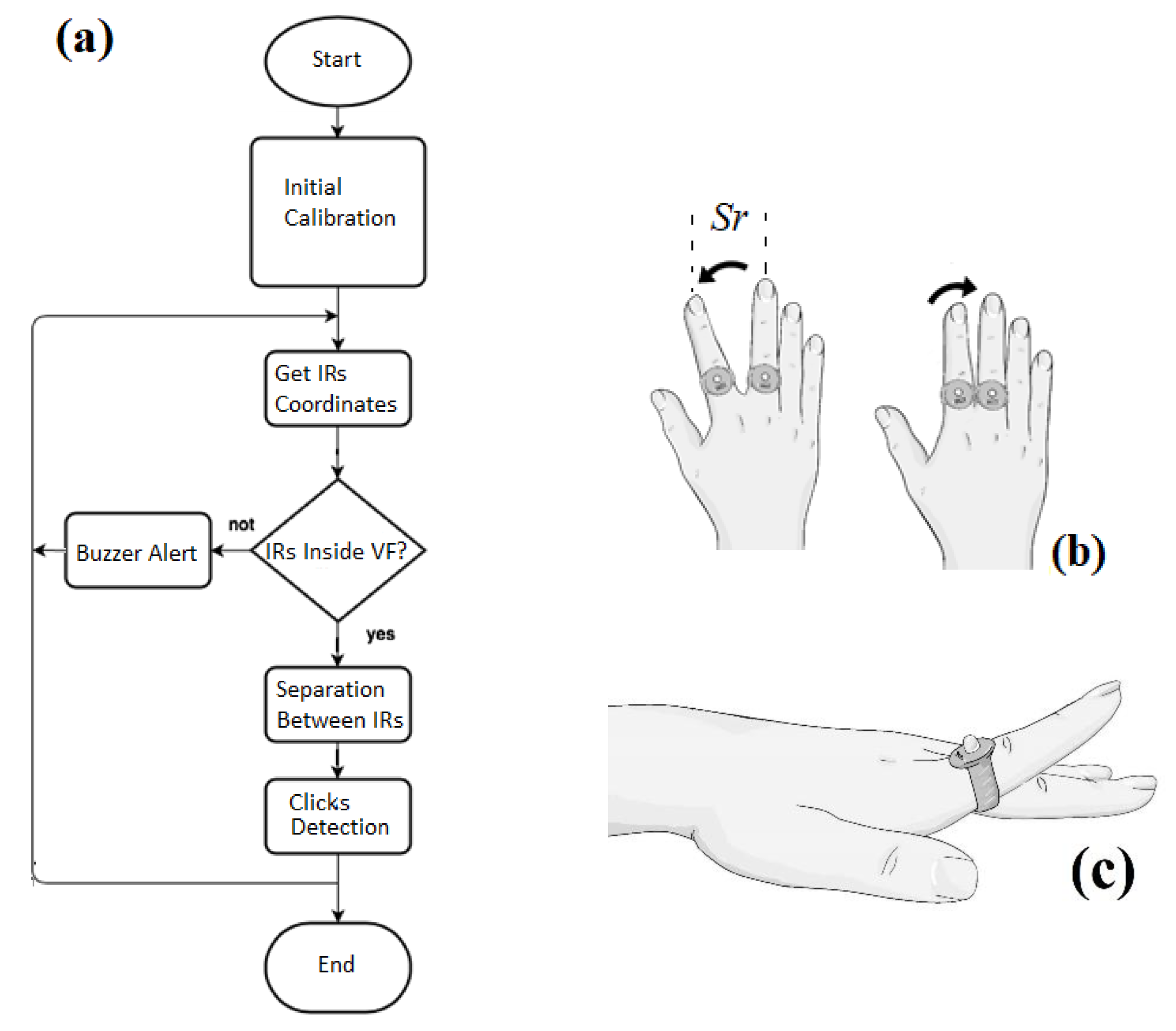



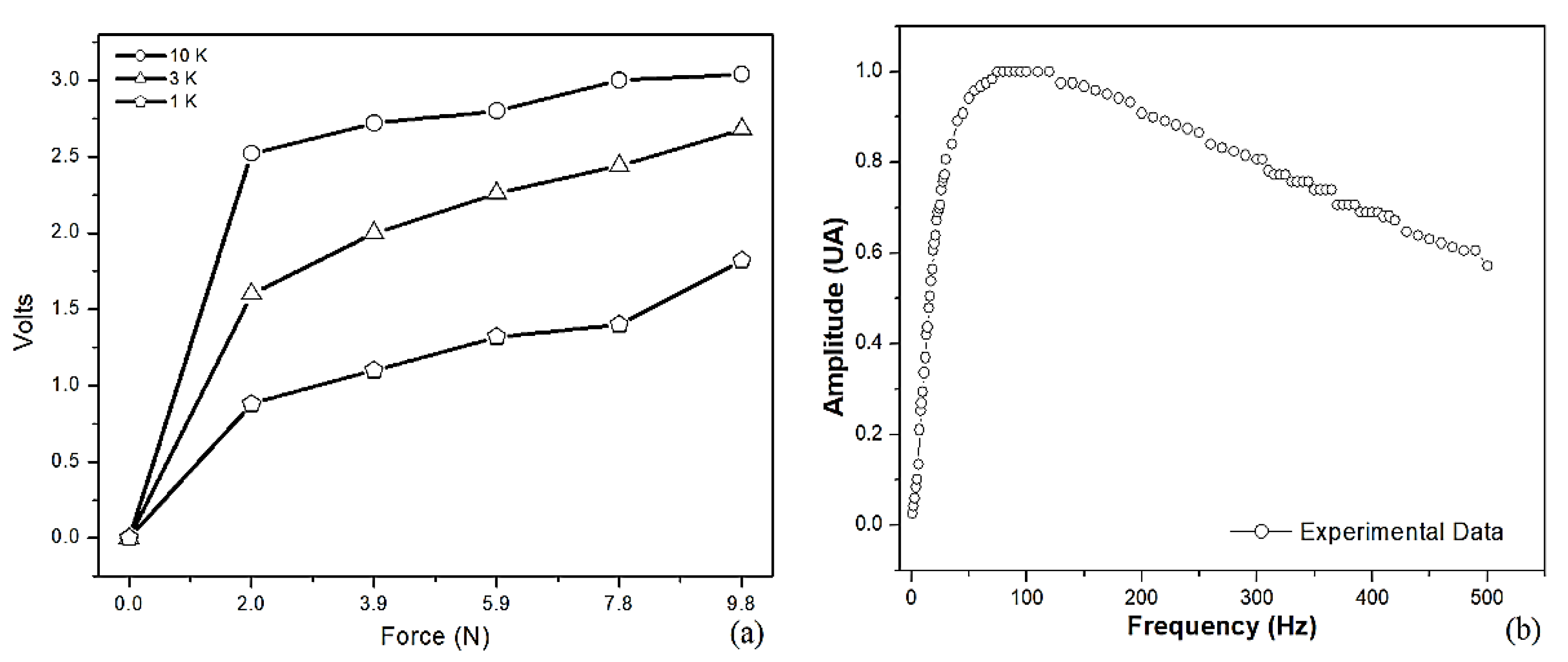

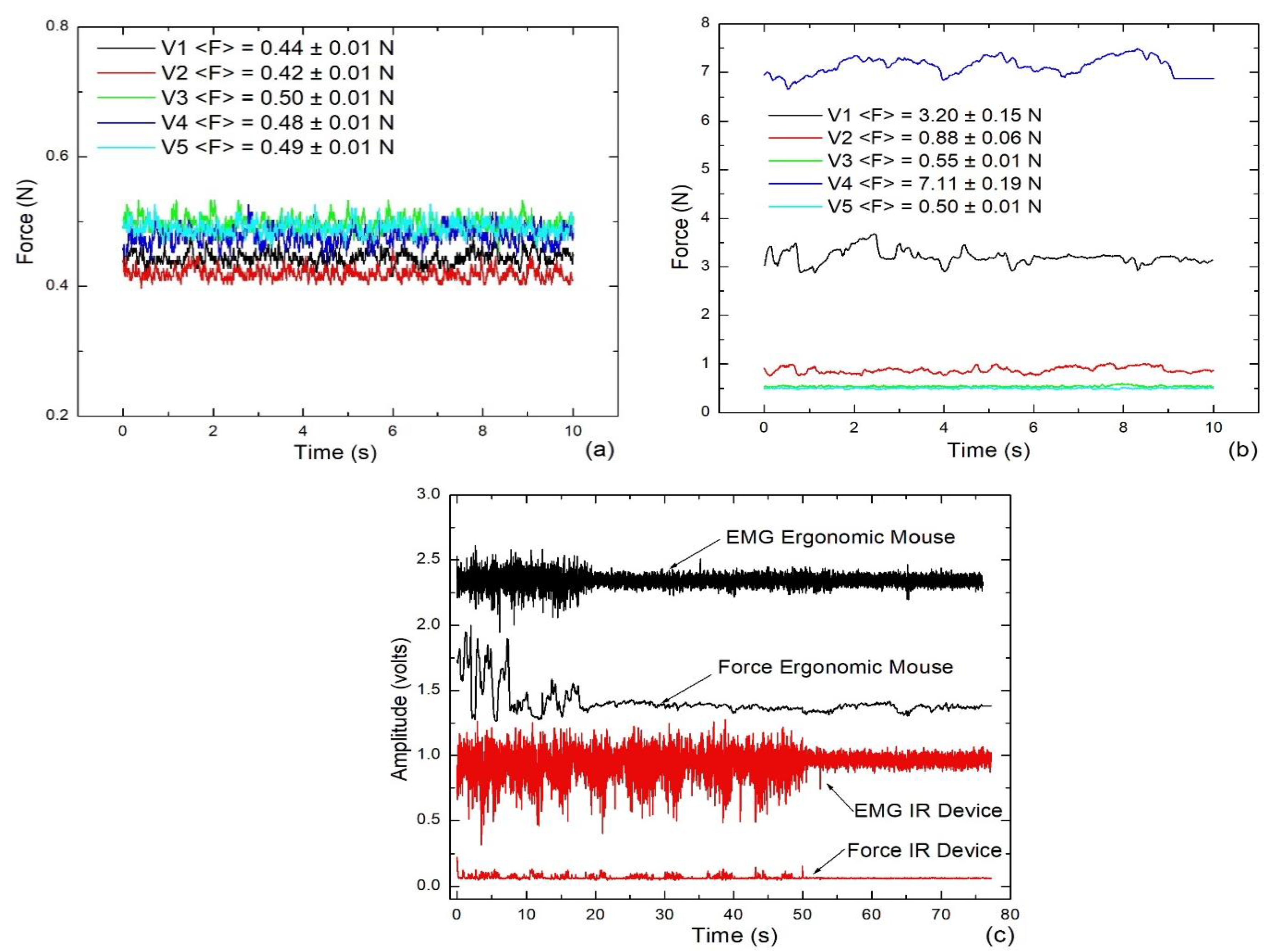
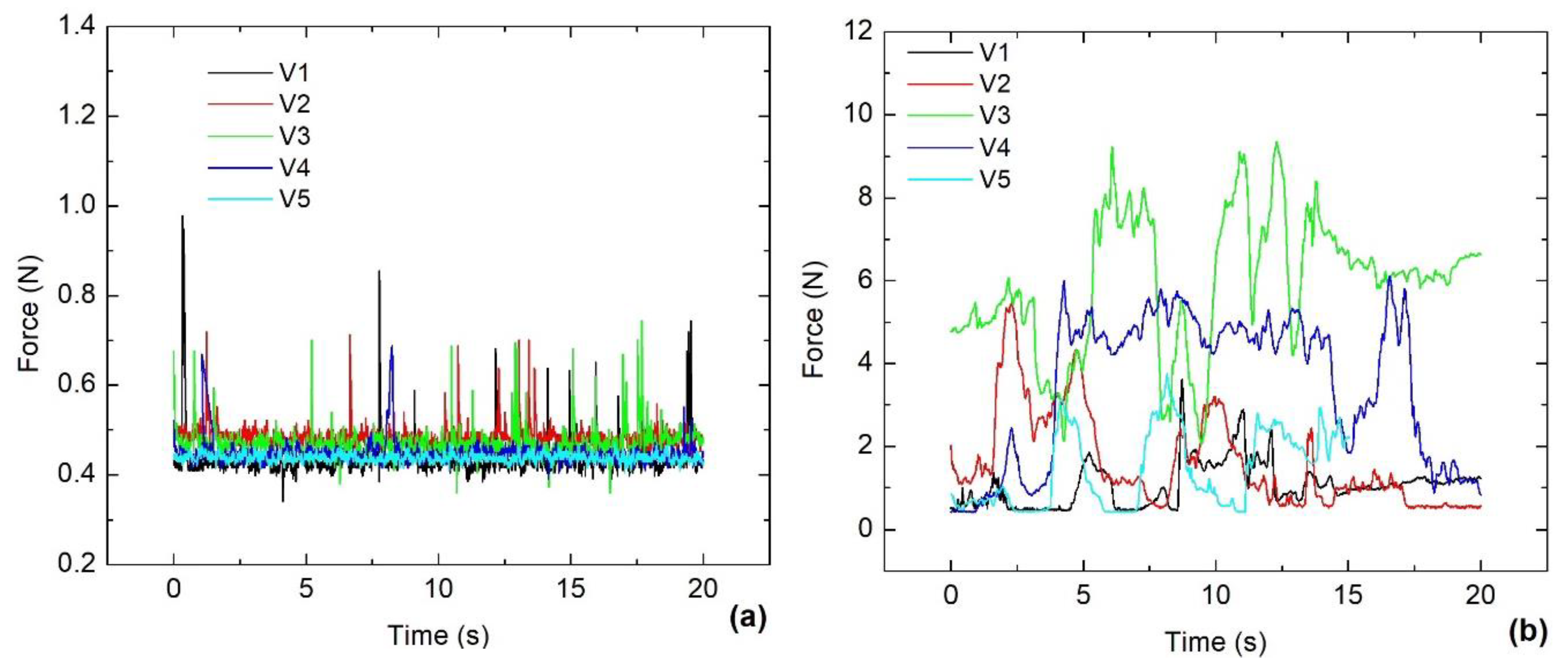
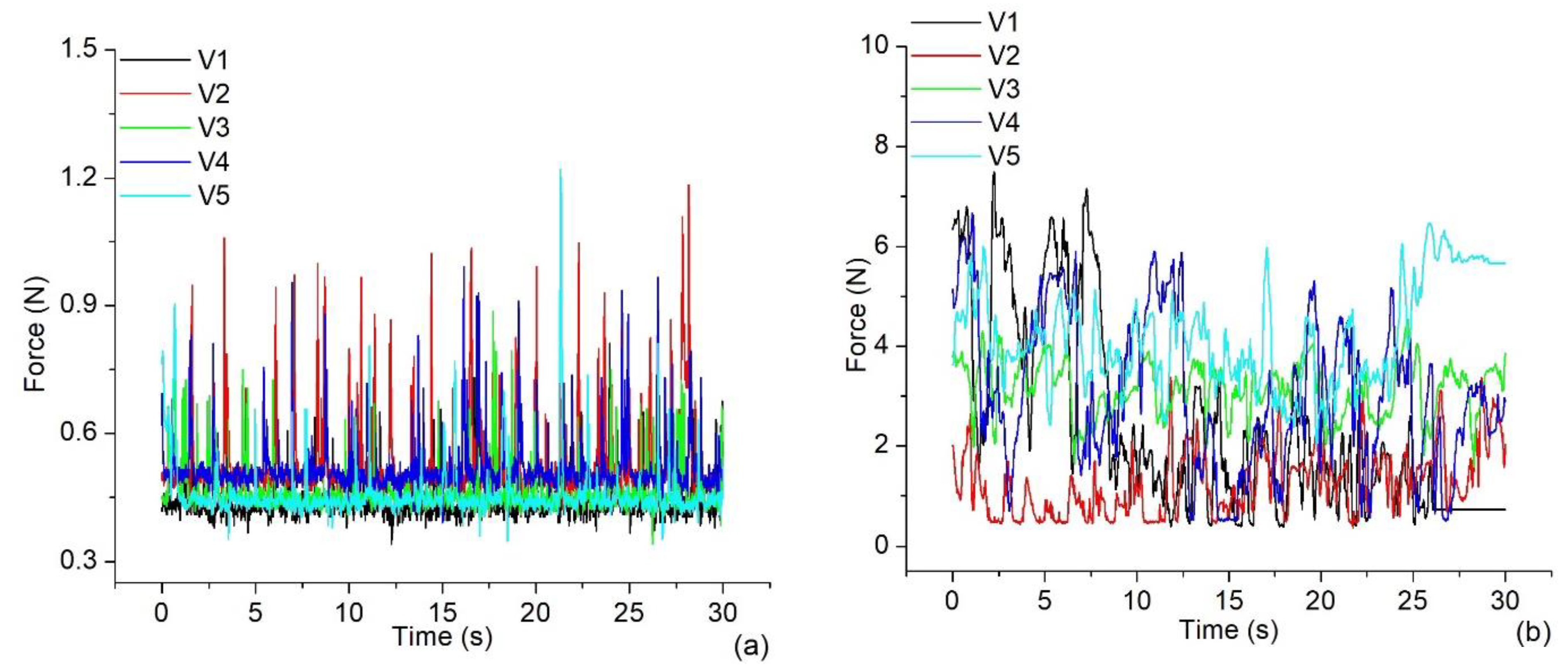
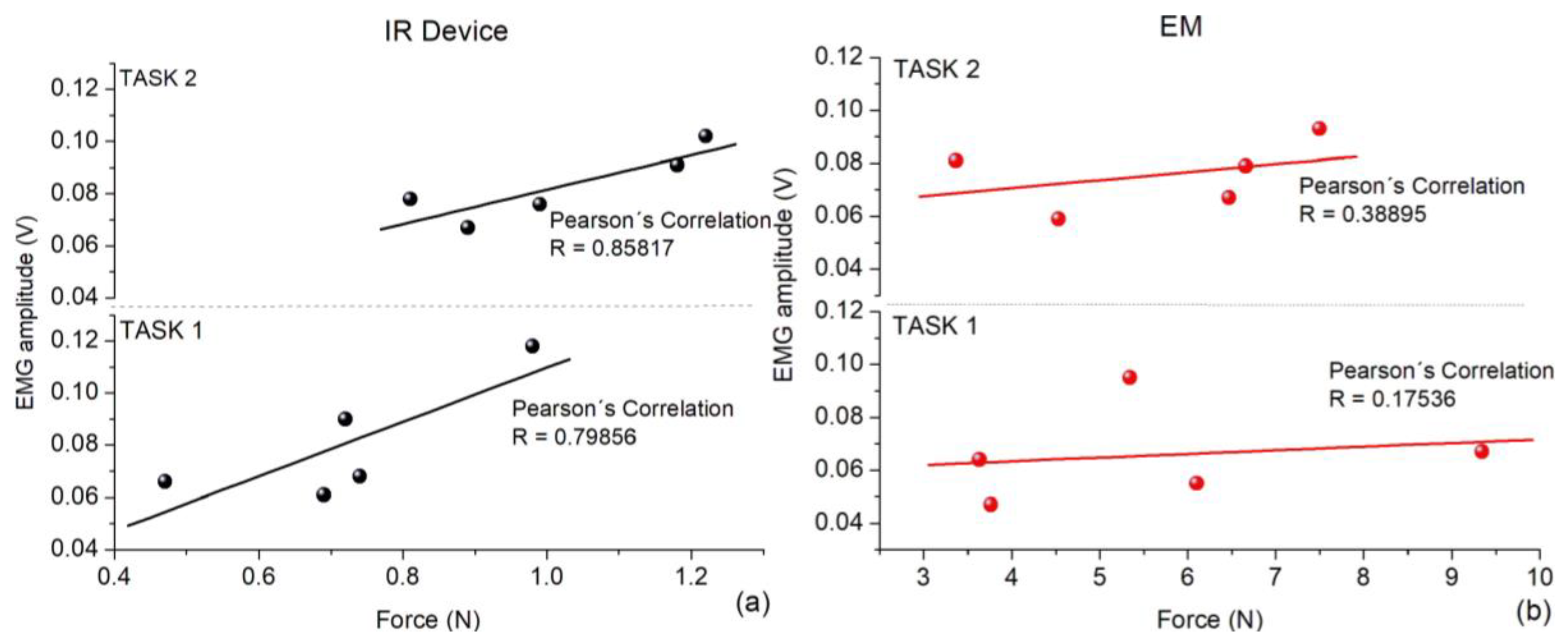
| Volunteer | IR Device SD (V) | Threshold (N) | EM SD (V) | Threshold (N) | IR Device Rest SD (V) | EM Rest SD (V) |
|---|---|---|---|---|---|---|
| V1 | 0.118 | 0.98 | 0.064 | 3.63 | 0.019 | 0.029 |
| V2 | 0.090 | 0.72 | 0.095 | 5.34 | 0.031 | 0.047 |
| V3 | 0.068 | 0.74 | 0.067 | 9.34 | 0.031 | 0.040 |
| V4 | 0.061 | 0.69 | 0.055 | 6.10 | 0.035 | 0.031 |
| V5 | 0.066 | 0.47 | 0.047 | 3.76 | 0.039 | 0.044 |
| Volunteer | IR Device SD (V) | Threshold (N) | EM SD (V) | Threshold (N) |
|---|---|---|---|---|
| V1 | 0.078 | 0.81 | 0.093 | 7.50 |
| V2 | 0.091 | 1.18 | 0.081 | 3.37 |
| V3 | 0.067 | 0.89 | 0.059 | 4.53 |
| V4 | 0.076 | 0.99 | 0.079 | 6.66 |
| V5 | 0.102 | 1.22 | 0.067 | 6.47 |
Disclaimer/Publisher’s Note: The statements, opinions and data contained in all publications are solely those of the individual author(s) and contributor(s) and not of MDPI and/or the editor(s). MDPI and/or the editor(s) disclaim responsibility for any injury to people or property resulting from any ideas, methods, instructions or products referred to in the content. |
© 2024 by the authors. Licensee MDPI, Basel, Switzerland. This article is an open access article distributed under the terms and conditions of the Creative Commons Attribution (CC BY) license (https://creativecommons.org/licenses/by/4.0/).
Share and Cite
Cholico, F.A.; Paz, J.A.; López, Z.; Hernández Sámano, A.; Mena-Barboza, E.; Bernal-Alvarado, J.; Velasquez, C.; Hernández-Gutiérrez, R.; Quintero, L.H.; Cano, M.E. Comparing the Pressure on the Carpal Tunnel When Using an Ergonomic Pointer Driver and an Optical Alternative. J. Funct. Morphol. Kinesiol. 2024, 9, 260. https://doi.org/10.3390/jfmk9040260
Cholico FA, Paz JA, López Z, Hernández Sámano A, Mena-Barboza E, Bernal-Alvarado J, Velasquez C, Hernández-Gutiérrez R, Quintero LH, Cano ME. Comparing the Pressure on the Carpal Tunnel When Using an Ergonomic Pointer Driver and an Optical Alternative. Journal of Functional Morphology and Kinesiology. 2024; 9(4):260. https://doi.org/10.3390/jfmk9040260
Chicago/Turabian StyleCholico, Francisco A., José A. Paz, Zaira López, Alfonso Hernández Sámano, Eri Mena-Barboza, José Bernal-Alvarado, Celso Velasquez, Rodolfo Hernández-Gutiérrez, Luis H. Quintero, and Mario E. Cano. 2024. "Comparing the Pressure on the Carpal Tunnel When Using an Ergonomic Pointer Driver and an Optical Alternative" Journal of Functional Morphology and Kinesiology 9, no. 4: 260. https://doi.org/10.3390/jfmk9040260
APA StyleCholico, F. A., Paz, J. A., López, Z., Hernández Sámano, A., Mena-Barboza, E., Bernal-Alvarado, J., Velasquez, C., Hernández-Gutiérrez, R., Quintero, L. H., & Cano, M. E. (2024). Comparing the Pressure on the Carpal Tunnel When Using an Ergonomic Pointer Driver and an Optical Alternative. Journal of Functional Morphology and Kinesiology, 9(4), 260. https://doi.org/10.3390/jfmk9040260







